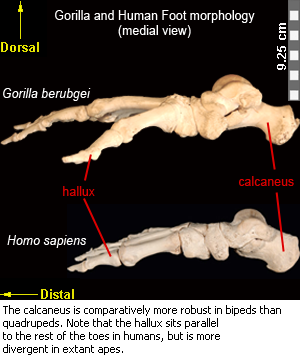 Humans have the most distinctive feet of all the apes. Since only the hindlimbs (or lower limbs) are used for propulsion, the body's entire torso weight (all of the forces generated by running, walking, and jumping) pass through only 1 foot at a time as the biped moves between the from swing and stance phases of locomotion. As a consequence, the foot anatomy must be robust enough to accommodate these forces, while also providing efficient toe-initiated push-off for propulsion. As an example, the hallux (i.e., big toe) in humans is much larger and more robust than the other four toes.
Humans have the most distinctive feet of all the apes. Since only the hindlimbs (or lower limbs) are used for propulsion, the body's entire torso weight (all of the forces generated by running, walking, and jumping) pass through only 1 foot at a time as the biped moves between the from swing and stance phases of locomotion. As a consequence, the foot anatomy must be robust enough to accommodate these forces, while also providing efficient toe-initiated push-off for propulsion. As an example, the hallux (i.e., big toe) in humans is much larger and more robust than the other four toes.
The calcaneus, or heel bone, is also relatively large and robust in humans compared to chimpanzees, especially the posterior portion known as the calcaneal tuberosity. As the first foot bone to contact the ground during the stride cycle, the robust of the calcaneus provides stability and helps absorb the high forces encountered during heel strike. In addition the shape of the calcaneus provides attachment points for strong ligaments that run from the arch of the foot to the tibia. These ligaments add support, creating a double arch system that helps to absorb stress as the foot hits the ground.
 The metatarsals are long thin bones in the middle of the foot between the tarsals (on the distal side) and the phalanges or toe bones (on the proximal side). Bipedalism can be inferred by examining the shape of the articular surfaces on tarsals that articulate with metatarsal I (i.e., the hallux). For example, the rounded articular surface on the ape media cuneiform premits a wide range of abduction. The human medial cuneiform, however, has a flattened articular surface which restricts the hallux to an adducted position. This means that the human hallux lies parallel to the other toes and lateral movement is severely limited.
The metatarsals are long thin bones in the middle of the foot between the tarsals (on the distal side) and the phalanges or toe bones (on the proximal side). Bipedalism can be inferred by examining the shape of the articular surfaces on tarsals that articulate with metatarsal I (i.e., the hallux). For example, the rounded articular surface on the ape media cuneiform premits a wide range of abduction. The human medial cuneiform, however, has a flattened articular surface which restricts the hallux to an adducted position. This means that the human hallux lies parallel to the other toes and lateral movement is severely limited.
The fully adducted hallux in humans is commonly referred to as a non-opposable big toe. In general, human toes are shorter in relative length than in other primates; and comparatively, humans have almost no grasping ability in their toes and feet. However, walking bipedally with longer toes and a divergent hallux would be energetically costly and impede efficient bipedalism, so relatively toe length is likely an adapation of obligate bipedalism9,19.
Evidence from the Laetoli Tracks in Tanzania, where footprints from several australopiths were preserved in volcanic ash, indicates that Australopithecus had relatively short toes, and an intermediately adducted hallux.
eFossils is a collaborative website in which users can explore important fossil localities and browse the fossil digital library. If you have any problems using this site or have any other questions, please feel free to contact us.
Funding for eFossils was provided by the Longhorn Innovation Fund for Technology (LIFT) Award from the Research & Educational Technology Committee (R&E) of the IT governance structure at The University of Texas at Austin.
